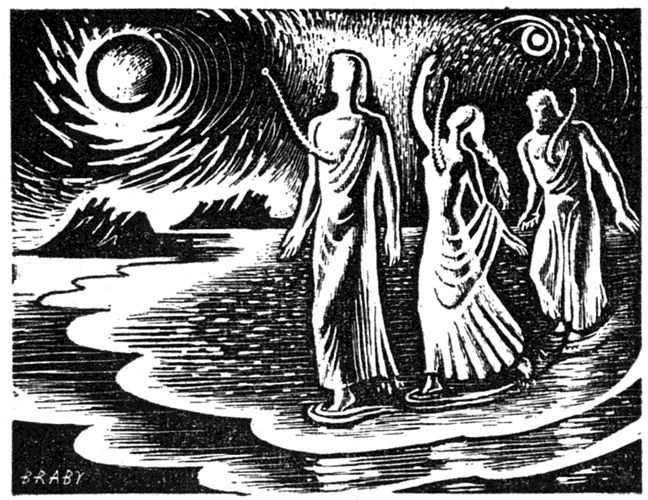This article was written to accompany the Third Programme radio adaptation of A Voyage to Arcturus:
An adaptation of David Lindsay’s novel, discussed here by E. H. VISIAK, will be broadcast on Sunday and Saturday (Third)
The late David Lindsay wrote two books of authentic genius — A Voyage to Arcturus, and The Haunted Woman. They had found few readers until Victor Gollancz discovered the author, and even today they are comparatively unknown; the same sort of time-lapse occurred, it will be remembered, after Clark Russell had discovered Herman Melville.
Yet Lindsay’s two masterpieces, like Melville’s, leave a profound impact, a sensational splash, and sink into the imaginative deep, although one may not at first consciously apprehend their significance. The man and girl who get into the sinister dimension of the eerie rooms in The Haunted Woman, look down upon the queer legendary countryside and understand nothing. They see a man seated upon a hill-top; his dress is gaily coloured like a tulip and he plays exciting music. His back is always turned towards them, and when the man goes out to face him, we still at first do not understand, but we feel the horror. The musician is Crystalman, the horrible charming Devil of A Voyage to Arcturus.
Whereas the Martians of H. G. Wells belong to physics, Lindsay’s Arcturusians — if one may coin the term — belong to metaphysics. Influencing them all is the fascinating, urbane, ubiquitous Crystalman — Blake’s Anti-Christ — the embodiment of pleasure, beauty, art. With his vast ‘shadow-form’ he comes between them and the rays of Muspel, the Sublime Light, and pollutes them like an infernal miasma. The result is that they become split as by a prism. In every creature one part, which suffers no change, but is minute, is imprisoned in the other part; this particle is comparable to Sir Thomas Browne’s ‘piece of divinity in man’, and would instinctively turn towards Muspel, its source, but is continually diverted by Crystalman, even in the most aspiring souls. If it were not for the intermediary of a Being who, fierce and terrible, strikes great blows of redemptive pain, the whole congeries of souls, diverted by beauty and depraved by pleasure, would sink into an abominable morass.
Strange books by a strange man! I wrote to him, and, although a recluse by nature, he was so impressed by this evidence of any interest in his work that he called on me. At first, he was stiff and formal, like his character, Judge, in The Haunted Woman, but as in that book the style is soon forgotten, so we soon broke through formality. He had a solemn soul, but no man, I hold, a readier sense of humour.
— E H Visiak, Radio Times, 22 June 1956, p.4


